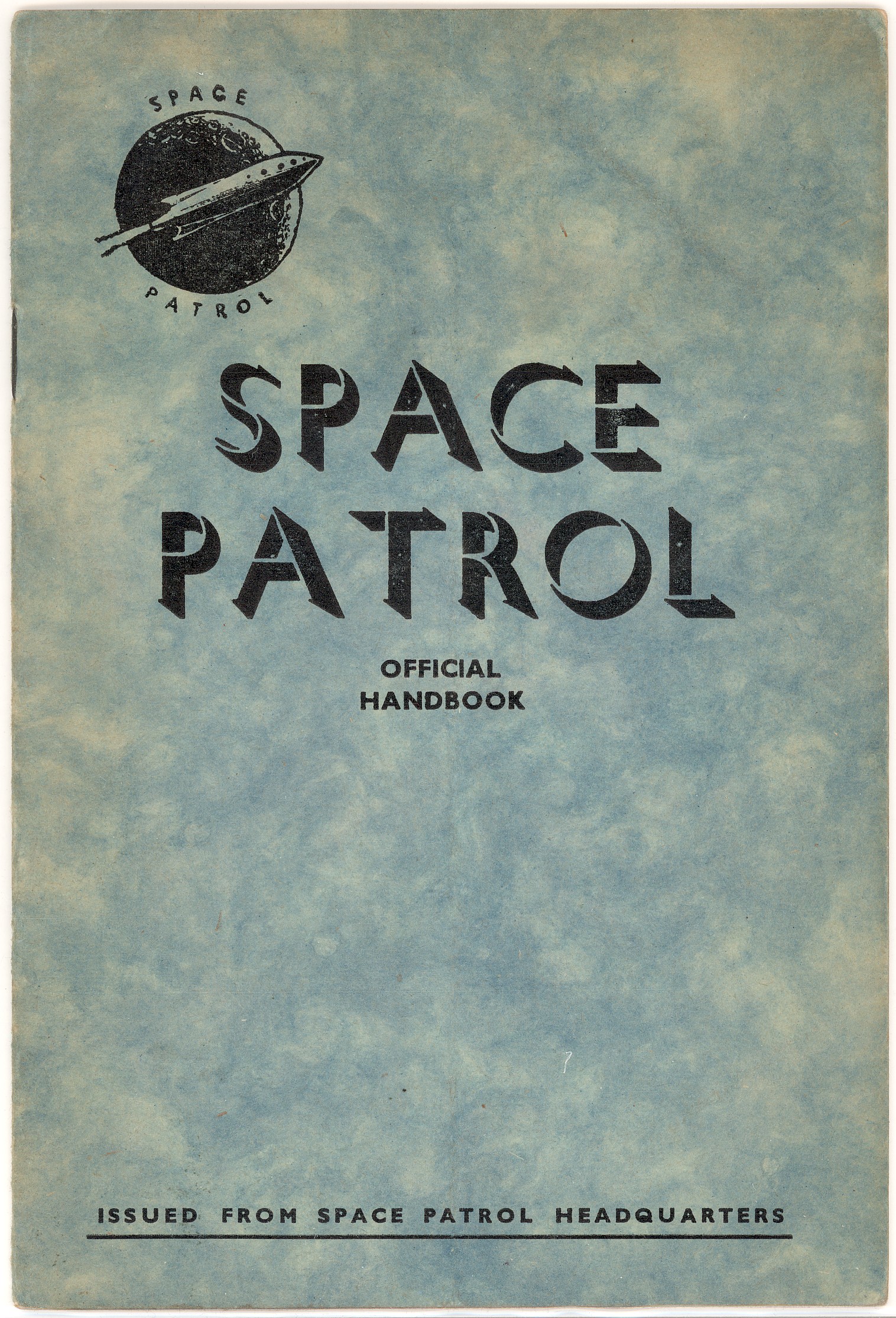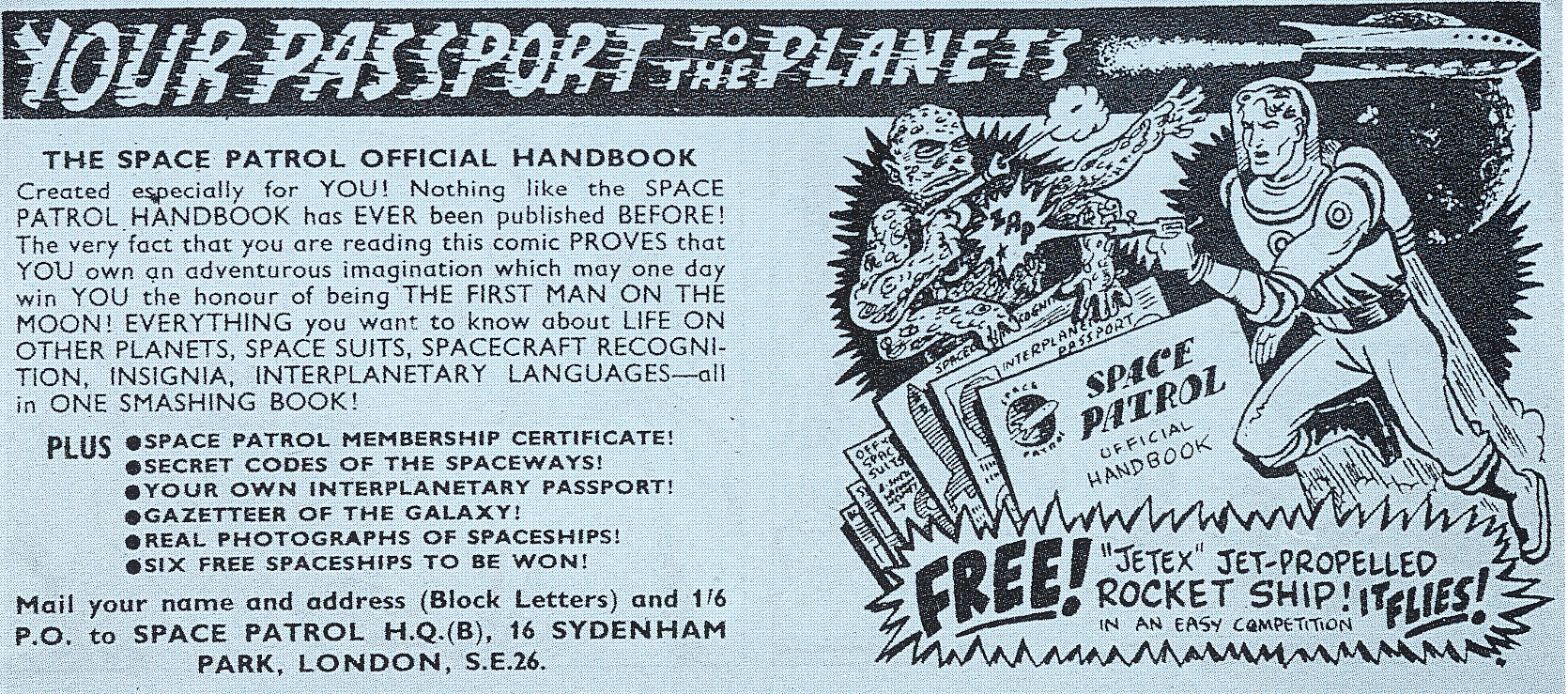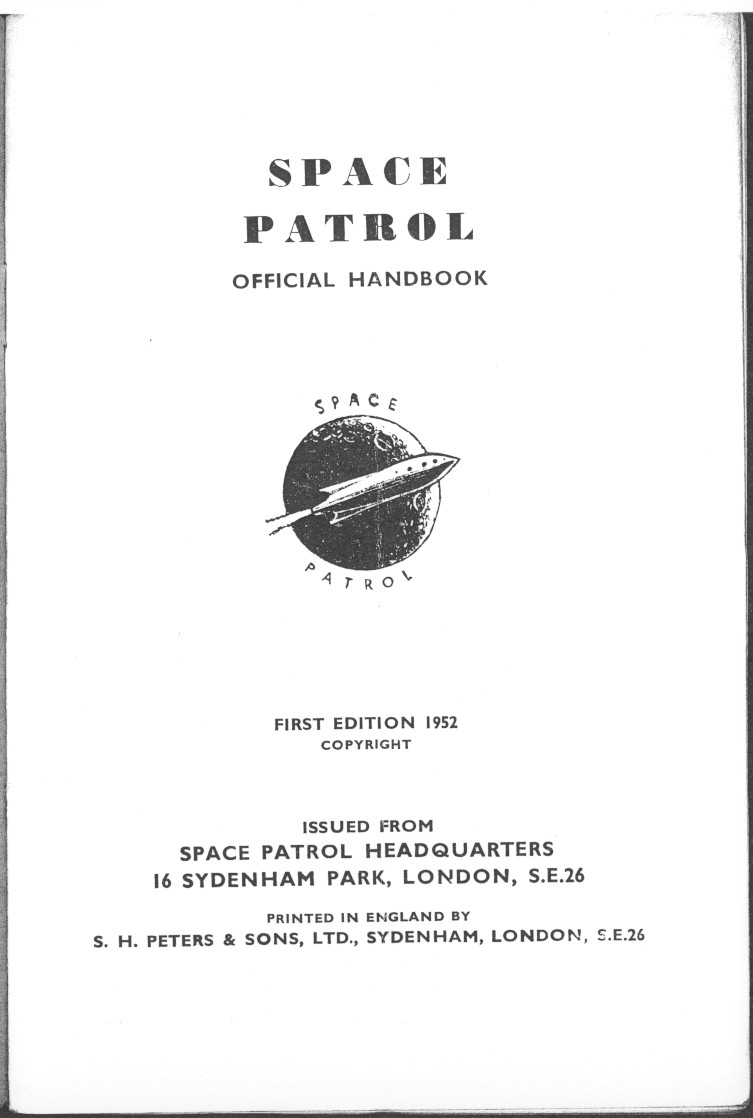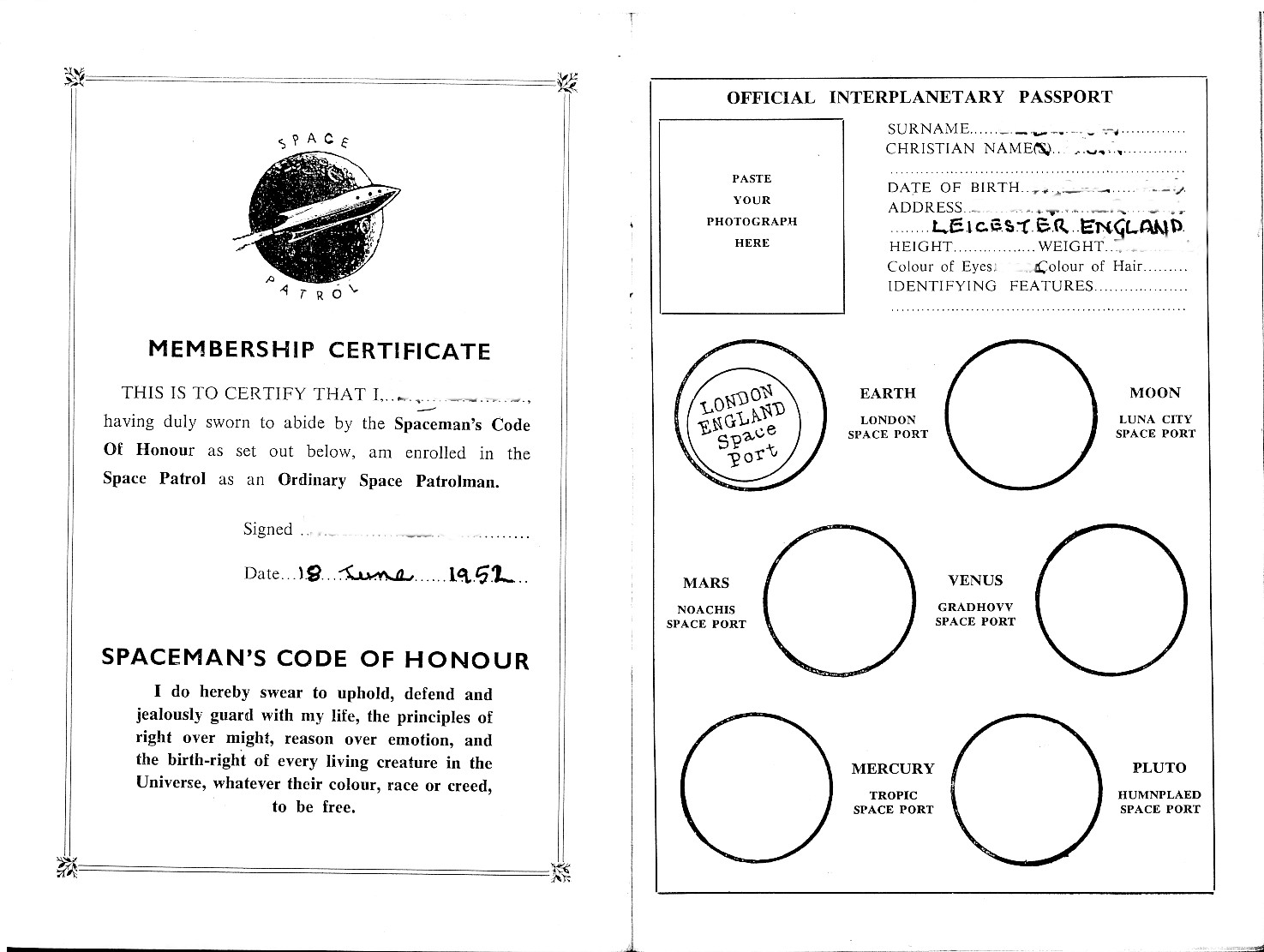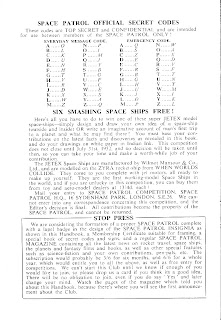Monday, January 31, 2011
The Man from Space (1955)
Nothing to do with space flight just an old cool cover. Get ready for your "First Vacation on the Moon".
Friday, January 28, 2011
What's on the Moon? (1965)
Reader's Digest may not be the first place you go to find children's books about space flight but I found one. In the 1960s there was a hunger for materials for the classroom. Reader's Digest evidently had a series of reprinted articles that they made available for classroom use. Although the cover is alluring, most of the articles inside were not about space. The cover on this is very Bonestellian. The space article reprinted is a 1963 article:
Maisel, Albert Q. "The Fantastic Hazards of Landing on the Moon" Reader's Digest Sept 1963.
On the inside is also a nice painting of men exploring the Moon.
Between "mountain climbing" and the huge cracks in the surface it looks like their Moon was a lot more exciting than "our" Moon. The adventure of going to the Moon. Of course because this was intended for schools there had to be a quiz on the material at the end of the "interesting" reading. Test your space knowledge (and knowledge of word endings)!
Maisel, Albert Q. "The Fantastic Hazards of Landing on the Moon" Reader's Digest Sept 1963.
On the inside is also a nice painting of men exploring the Moon.
Between "mountain climbing" and the huge cracks in the surface it looks like their Moon was a lot more exciting than "our" Moon. The adventure of going to the Moon. Of course because this was intended for schools there had to be a quiz on the material at the end of the "interesting" reading. Test your space knowledge (and knowledge of word endings)!
P.S. Are you getting ready for your “First Vacation on the Moon?
Wednesday, January 26, 2011
Wonders of Space Stamps (1954)
These "Golden Books" were everywhere and there were stamps for all sorts of subjects. This is the earliest of the space related stamps books. Each stamp is a little jewel of space art.
Bernhard, Hubert. Illustrated by Solonewitsch, George and Discount, William. Wonders of Space Stamps: An Exciting Account of the Stars, Sun, Planets, and Other Wonders of the Sky. New York: Simon and Schuster. (48 p.) 28 cm. (1954)
There are so many images that rather than scan each I scanned the sheets of stamps.
These stamp books had simple text and 48 color stamps to glue in the appropriate places. George Solonewitsch's stamp art includes paintings of the planets and a rocket to the Moon.
But you should not discount a little extra space art from William Discount (sorry). His drawings of a couple of space scenes to go with the stamps are also a hidden treasure.
This is the only page that has any space flight text but these next few images are nicely futuristic about what children could expect from space flight.
Beside the Moon mankind would also eventually go to tthe other planets.
A very nice book. P.S. your "First Vacation on the Moon" is coming up soon!
Bernhard, Hubert. Illustrated by Solonewitsch, George and Discount, William. Wonders of Space Stamps: An Exciting Account of the Stars, Sun, Planets, and Other Wonders of the Sky. New York: Simon and Schuster. (48 p.) 28 cm. (1954)
There are so many images that rather than scan each I scanned the sheets of stamps.
These stamp books had simple text and 48 color stamps to glue in the appropriate places. George Solonewitsch's stamp art includes paintings of the planets and a rocket to the Moon.
But you should not discount a little extra space art from William Discount (sorry). His drawings of a couple of space scenes to go with the stamps are also a hidden treasure.
This is the only page that has any space flight text but these next few images are nicely futuristic about what children could expect from space flight.
Beside the Moon mankind would also eventually go to tthe other planets.
A very nice book. P.S. your "First Vacation on the Moon" is coming up soon!
Monday, January 24, 2011
To the Moon by Rocket Ship (1940)
I have very few pre-1950s items in my collection. Since my focus is primarily children's non-fiction about space flight there are now many earlier examples. One might be this 1940 pamphlet from the Fels Planetarium in Philadelphia. At the time a few planetariums were having special shows that took visitors on an imaginary voyage into space.
This pamphlet collected the facts and gave the visitor something to take home. While primitive in appearance I image many children who were in love with Buck Rogers being facinated that it might someday all be true.
The text give you the feeling that the presentation was sort of like an early version of the modern science fiction epic where you are immersed in an science fiction adventure to the Moon.
This pamphlet collected the facts and gave the visitor something to take home. While primitive in appearance I image many children who were in love with Buck Rogers being facinated that it might someday all be true.
The text give you the feeling that the presentation was sort of like an early version of the modern science fiction epic where you are immersed in an science fiction adventure to the Moon.
Friday, January 21, 2011
Do You Know About Our Solar System? (1963)
A quick one on a Friday. While most of this book has pictures of the planets it does have one excellent illustration worth sharing.
King, H C. Illustrated by Hall, Roger. Do You Know about Our Solar System. London : Collins Sons and Co. (48 p.) 27 cm. Cloth. (1963)
Mostly concerned with astronomy, there are illustrations of space probes, the surfaces of several planets and a manned landing on the Moon. "Pageant of Knowledge" series.
King, H C. Illustrated by Hall, Roger. Do You Know about Our Solar System. London : Collins Sons and Co. (48 p.) 27 cm. Cloth. (1963)
Mostly concerned with astronomy, there are illustrations of space probes, the surfaces of several planets and a manned landing on the Moon. "Pageant of Knowledge" series.
Tuesday, January 18, 2011
The Illustrated Story of Space (Classics Illustrated) (1959)
This is the cover you would have found on the American edition of this comic book and this is the British cover:
I like how they chose to "flip" the image.
Classics Illustrated were comics books intended to educate as well as entertain. They often were fictional "classic" books in comic book form such as Moby Dick. They also had a special series called "The World around Us." These were non-fiction comic books about topics of interest.
Classics Illustrated. Illustrated by McCann, Gerald, Glanzman, Sam, and Tartaglione, John. The Illustrated Story of Space. Classics Illustrated. (80 p.) 26 cm. Softcover.
Contains illustrated stories on training for space, the first rocket to the Moon, the history and use of the rocket, the launch of Vanguard 1, and the construction of a space station. "The World Around Us" (#5) January 1959.
"These are no longer the dreams of science fiction. They are part of real life."
The excitement of assembling a space station
Just page after page of excitement about what was just around the corner...
The ship they chose for the landing on the Moon seems a little odd. Why carry a winged plane all the way to the Moon when you will leave and return to a space station?
I also love the angle they chose for this illustration. You really feel like you are climbing down to the surface.
"When you're ready to go to the planets, sir, I'll be standing by!"
I like how they chose to "flip" the image.
Classics Illustrated were comics books intended to educate as well as entertain. They often were fictional "classic" books in comic book form such as Moby Dick. They also had a special series called "The World around Us." These were non-fiction comic books about topics of interest.
Classics Illustrated. Illustrated by McCann, Gerald, Glanzman, Sam, and Tartaglione, John. The Illustrated Story of Space. Classics Illustrated. (80 p.) 26 cm. Softcover.
Contains illustrated stories on training for space, the first rocket to the Moon, the history and use of the rocket, the launch of Vanguard 1, and the construction of a space station. "The World Around Us" (#5) January 1959.
"These are no longer the dreams of science fiction. They are part of real life."
The excitement of assembling a space station
Just page after page of excitement about what was just around the corner...
The ship they chose for the landing on the Moon seems a little odd. Why carry a winged plane all the way to the Moon when you will leave and return to a space station?
I also love the angle they chose for this illustration. You really feel like you are climbing down to the surface.
"When you're ready to go to the planets, sir, I'll be standing by!"
Friday, January 14, 2011
Space Patrol Official Handbook (1952)
This is a re-run for you fans of my old Dreams of Space site but I wanted to tell the story again.
This is a booklet that I was amazed to find and even more amazing was that the only mention of it was buried in the introduction of a totally different book I had read 8 months before I ever saw this book. And it has nothing to do with the old Space Patrol TV series.
From the Introduction to Space Aces! Comic Book Heroes from the Forties and Fifties by Denis Gifford 1992.
"My own entry into the sci-fi world really happened in 1952. I was drawing 'Flip and Flop' and other comic characters for Mick Anglo's comic-books when I conceived my great idea. Within a month I had compiled and launched Space Patrol Official Handbook, from the Space Patrol Headquarters, 16 Sydenham Park, SE26! 'Your Passport to the Planets', as I advertised it, contained 'Everything you want to know about the Life on Other Planets, Space Suits, Spacecraft Recognition, Insignia, Interplanetary Languages - plus Space Patrol Membership Certificate! Secret Codes of the Spaceways! Interplanetary Passport! Gazetteer of the Galaxy! Real Photographs of Spaceships! (pinched from space films, of course) and the Space Man's Code of Honour!' Also a 'Free Jet-ex Jet-propelled Rocket Ship in Easy Competition! - It Flies!' All this and more in one twenty-page blue-covered booklet for a one-and-sixpenny Postal order! A word of warning - don't send a 1s 6d PO to SPHQ, will you? I sold out and moved! Anyway, as there are only two known copies left, the Handbook would now cost a little more than seven and a half pence!"
There was even a copy of the old advertisement he had reproduced in the book:
Well with only 2 copies around I never thought I would see this book in my space book hunting.
The booklet is a marvel of homemade early science fiction fandom. It mixes movies, old science fiction ideas, and a dash of space science.
Since it is so "rare" I am happy to share with you this essential guide to spaceflight.
As you can see he was shameless in borrowing from the science fiction films of the time.
The question is this raises is simple. Is this a unique item? It is certainly obscure but I have had some else write me to say that they had one too. So is this simply amateur science fiction or is it the ultimate expression of that child within us that wants to tell everyone about how cool spaceflight is?
I think the guy was hoping to make a little money off of cashing in on the latest fad. This book represents to me why I started collecting these things. They are obscure and forgotten but someone needs to save them and make sure future generations can appreciate how wonderful the early space age was. For I do believe we are part of the early space age and there is a lot more to come.
This is a booklet that I was amazed to find and even more amazing was that the only mention of it was buried in the introduction of a totally different book I had read 8 months before I ever saw this book. And it has nothing to do with the old Space Patrol TV series.
From the Introduction to Space Aces! Comic Book Heroes from the Forties and Fifties by Denis Gifford 1992.
"My own entry into the sci-fi world really happened in 1952. I was drawing 'Flip and Flop' and other comic characters for Mick Anglo's comic-books when I conceived my great idea. Within a month I had compiled and launched Space Patrol Official Handbook, from the Space Patrol Headquarters, 16 Sydenham Park, SE26! 'Your Passport to the Planets', as I advertised it, contained 'Everything you want to know about the Life on Other Planets, Space Suits, Spacecraft Recognition, Insignia, Interplanetary Languages - plus Space Patrol Membership Certificate! Secret Codes of the Spaceways! Interplanetary Passport! Gazetteer of the Galaxy! Real Photographs of Spaceships! (pinched from space films, of course) and the Space Man's Code of Honour!' Also a 'Free Jet-ex Jet-propelled Rocket Ship in Easy Competition! - It Flies!' All this and more in one twenty-page blue-covered booklet for a one-and-sixpenny Postal order! A word of warning - don't send a 1s 6d PO to SPHQ, will you? I sold out and moved! Anyway, as there are only two known copies left, the Handbook would now cost a little more than seven and a half pence!"
There was even a copy of the old advertisement he had reproduced in the book:
Well with only 2 copies around I never thought I would see this book in my space book hunting.
The booklet is a marvel of homemade early science fiction fandom. It mixes movies, old science fiction ideas, and a dash of space science.
Since it is so "rare" I am happy to share with you this essential guide to spaceflight.
As you can see he was shameless in borrowing from the science fiction films of the time.
The question is this raises is simple. Is this a unique item? It is certainly obscure but I have had some else write me to say that they had one too. So is this simply amateur science fiction or is it the ultimate expression of that child within us that wants to tell everyone about how cool spaceflight is?
I think the guy was hoping to make a little money off of cashing in on the latest fad. This book represents to me why I started collecting these things. They are obscure and forgotten but someone needs to save them and make sure future generations can appreciate how wonderful the early space age was. For I do believe we are part of the early space age and there is a lot more to come.
Monday, January 10, 2011
Casper Presents Space-Age Dentistry (1972)
Happy New Year! this post is a follow-up of sorts to my post on December 13 about the Casper Apollo 16 poster http://dreamsofspace.blogspot.com/2010/12/apollo-16-poster-with-casper-friendly.html
I am always interested in the stories behind my books and ephemera so I have been looking for more about Casper and Apollo 16. I found this 1972 promotional comic about dentistry, Apollo, and Casper!
The comic has a number of space references in the background, although unfortunately no image from my poster.
I have some scans of selected pages from the comic that reference space flight and Apollo. It never says Apollo 16 in the comic but from the date of the comic this must have been a quick promotional item printed to take advantage of the connection.
I continue to be fascinated by how space flight ideas were imbedded in popular culture. If you notice the ubiquitous Apollo mission poster and model behind the children in the dentist's office. This diagram needed no explanation as a summary of how we got to the Moon.
If it wasn't for the poster I found I would never have known about this connection between a cartoon ghost and one of our great adventures of the 20th century. I also might have missed learning about "Space-age dentistry."
I would have never even bothered to look for this piece of popular culture. It really places this comic squarely in the 1970s when the last line of the comic is "Right on!"
I am always interested in the stories behind my books and ephemera so I have been looking for more about Casper and Apollo 16. I found this 1972 promotional comic about dentistry, Apollo, and Casper!
The comic has a number of space references in the background, although unfortunately no image from my poster.
I have some scans of selected pages from the comic that reference space flight and Apollo. It never says Apollo 16 in the comic but from the date of the comic this must have been a quick promotional item printed to take advantage of the connection.
I continue to be fascinated by how space flight ideas were imbedded in popular culture. If you notice the ubiquitous Apollo mission poster and model behind the children in the dentist's office. This diagram needed no explanation as a summary of how we got to the Moon.
If it wasn't for the poster I found I would never have known about this connection between a cartoon ghost and one of our great adventures of the 20th century. I also might have missed learning about "Space-age dentistry."
I would have never even bothered to look for this piece of popular culture. It really places this comic squarely in the 1970s when the last line of the comic is "Right on!"




























